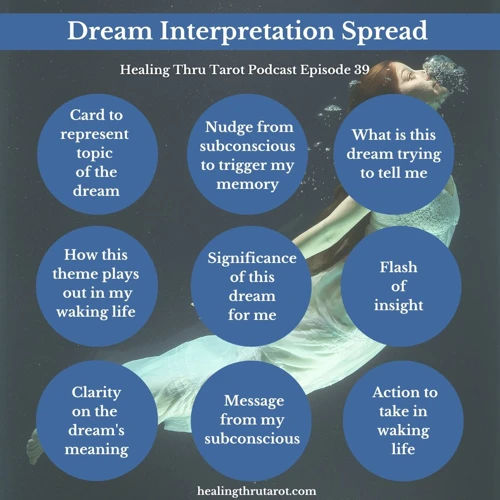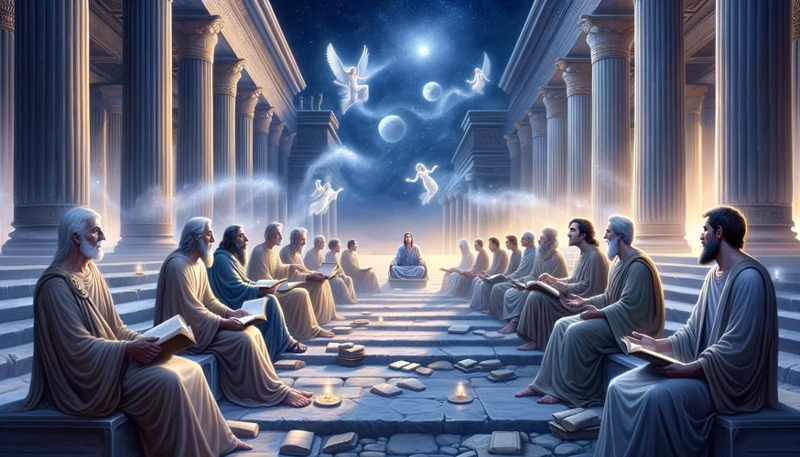Decoding the Meaning of Tarot Cards in Dreams

Have you ever had a dream that seemed to hold a deeper, mysterious message? Dreams have long been regarded as windows to our subconscious minds, revealing hidden truths and offering guidance. Tarot cards, with their rich symbolism and intricate imagery, have also been used for centuries to unlock the mysteries of our lives. But what happens when these two powerful tools converge? In this article, we will explore the fascinating world of dream analysis and tarot card interpretation, delving into the history of tarot cards, the power of dreams, and how to decipher the meaning of tarot cards in dreams. Get ready to embark on a journey of self-discovery and uncover the secrets that lie within your dreams.
Understanding Tarot Cards

Tarot cards are a powerful tool for self-reflection and introspection, offering insights into various aspects of our lives. Each card in a tarot deck holds a unique meaning and symbolism, representing different life experiences, emotions, and archetypes. Understanding the rich history of tarot cards is crucial to grasp their significance in dream interpretation. A Brief History of Tarot Cards: Tarot cards originated in the 15th century in Europe and were initially used as playing cards. Over time, they evolved into a divination tool used for spiritual guidance. Today, tarot cards are popularly associated with fortune-telling and gaining insights into the past, present, and future. Additionally, tarot cards are divided into two main categories—the Major Arcana and the Minor Arcana. The Major Arcana consists of 22 cards, each representing major life lessons and spiritual growth. The Minor Arcana comprises four suits—Cups, Pentacles, Swords, and Wands—which correspond to emotional, material, mental, and spiritual aspects of life. By gaining a deeper understanding of the symbolism and interpretation of tarot cards, we can unlock their significance in our dreams and gain valuable insights into our subconscious minds.
A Brief History of Tarot Cards
Tarot cards have a fascinating history that dates back to the 15th century in Europe. Initially used as playing cards, they eventually became a tool for divination and spiritual guidance. Today, tarot cards are commonly associated with fortune-telling and accessing insights into the past, present, and future. They are divided into the Major Arcana and Minor Arcana, each representing different aspects of life. The Major Arcana consists of 22 cards symbolizing major life lessons and spiritual growth. The Minor Arcana is comprised of four suits that correspond to emotions, material aspects, mental states, and spirituality. By understanding the history and symbolism of tarot cards, we can unlock their significance in dream interpretation and gain valuable insights into our subconscious minds.
The Symbolism and Interpretation of Tarot Cards
Tarot cards hold a vast array of symbolism and offer multiple layers of interpretation. Each card carries its own unique meaning, and when interpreted collectively, they form a narrative that reflects our journey through life. The symbolism within tarot cards encompasses various elements, including colors, numbers, astrological associations, and archetypal figures. For example, the High Priestess represents intuition and hidden knowledge, while the Tower signifies sudden change and upheaval. The interpretation of tarot cards involves considering the individual card’s symbolism, its position within a spread, and the surrounding cards. The cards can be interpreted literally or symbolically, depending on the context and the reader’s intuition. By exploring the symbolism and interpretation of tarot cards, we gain a deeper understanding of their role in dream analysis and uncover the intricate messages they convey about our subconscious thoughts and desires.
The Power of Dreams

Dreams have long fascinated and perplexed us, offering glimpses into the depths of our unconscious minds. They hold a power that transcends the boundaries of our waking reality, providing insights, symbolism, and messages that can guide us on our journey of self-discovery. Dreams as a Window to the Unconscious Mind: When we dream, our subconscious mind takes the stage, expressing thoughts, emotions, and desires that may be suppressed or overlooked during our waking hours. Dreams offer a unique opportunity to explore our fears, hopes, and unresolved issues, allowing us to tap into our inner wisdom and gain a deeper understanding of ourselves. Whether they are vivid or fleeting, dreams often carry significant meaning, serving as a means of communication between our conscious and unconscious selves. By paying attention to our dreams and analyzing their symbolism, we can uncover hidden truths, gain clarity, and even find solutions to real-life challenges. So next time you wake up from a captivating dream, take a moment to ponder its meaning and embrace the power that your dreams hold.
Dreams as a Window to the Unconscious Mind
Dreams have long been recognized as a powerful gateway to the unconscious mind. They provide a unique glimpse into our inner thoughts, emotions, fears, and desires. When we dream, our subconscious mind takes the stage, often expressing itself through symbols, metaphors, and surreal narratives. The Role of Symbols in Dream Analysis: Dreams are a language of symbols, each holding its unique meaning and significance. These symbols can be universal, such as water representing emotions, or personal, with individualized meanings based on one’s experiences. Analyzing and interpreting these symbols can offer profound insights into our subconscious mind and help us uncover unresolved issues, desires, or fears we may not be fully aware of. Dream analysis allows us to explore the depths of our psyche, gaining a better understanding of ourselves, our relationships, and the world around us. By delving into the symbolism of our dreams, we can unlock the wisdom hidden within our unconscious mind and bring about personal growth and transformation.
The Role of Symbols in Dream Analysis
Symbols play a crucial role in dream analysis, providing valuable clues to the deeper meanings and messages hidden within our dreams. Dreams often communicate through symbolisms, using images, objects, or actions that hold significance to the dreamer. These symbols can be personal, cultural, or universal in nature, and their interpretation requires a deep understanding of their context and representation. The Role of Symbols in Dream Analysis: Symbols act as a bridge between the conscious and unconscious mind, allowing us to explore our emotions, desires, fears, and experiences in a metaphorical way. Analyzing and interpreting these symbols helps us uncover subconscious patterns, unresolved conflicts, and the guidance our dreams offer. For example, dreaming about a snake may symbolize transformation or healing, while dreaming about flying could indicate a sense of liberation or freedom. By recognizing and interpreting the symbols present in our dreams, we gain access to profound insights and a deeper understanding of ourselves and our subconscious mind.
Interpreting Tarot Cards in Dreams

The fascinating realm of dream analysis offers us a gateway to the unconscious mind, where symbols and messages from our inner selves emerge. When tarot cards make an appearance in our dreams, they carry a significant weight and can hold profound meaning. Common Tarot Card Dreams and Their Meanings: Dreams involving tarot cards can vary greatly, but certain patterns and symbols tend to recur. For example, if you dream of The Fool card, it could symbolize new beginnings, taking risks, or embracing spontaneity. The appearance of The Death card in a dream might not be as ominous as it seems, as it often represents transformation and the end of a cycle. Other factors such as the specific cards, their positions, and the overall atmosphere of the dream must be considered when interpreting tarot card dreams. Reflecting on your emotions and experiences within the dream can provide additional insights into the message your subconscious is trying to convey. By delving into the symbolism and analyzing the context of tarot cards within dreams, you can unlock the hidden meanings and gain a deeper understanding of yourself and your journey.
Common Tarot Card Dreams and Their Meanings
When it comes to tarot card dreams, certain cards tend to appear more frequently, each carrying its own unique meaning and symbolism. Here are some common tarot card dreams and their interpretations:
- The Fool: Dreaming of The Fool card signifies new beginnings and taking risks in your life. It suggests embracing a sense of adventure and stepping into the unknown.
- The Tower: Seeing The Tower card in your dream often represents sudden change or upheaval. It may indicate a need to let go of old beliefs or structures that no longer serve you.
- The Lovers: Dreaming of The Lovers card often symbolizes choices and relationships. It may reflect a need to make important decisions or explore deeper connections with others.
- The Death: The Death card in your dream is not necessarily a negative omen. It signifies a transformative phase and the end of a particular chapter in your life, making way for new beginnings.
- The High Priestess: Seeing The High Priestess card in your dream indicates the presence of intuition and inner wisdom. It suggests a need to trust your instincts and delve deeper into your subconscious mind.
These are just a few examples, and the interpretation of tarot card dreams can vary based on individual experiences and the context of the dream itself. Keep in mind that the interpretation should always be personalized and reflective of your own inner journey. Exploring the meaning of tarot cards in your dreams can provide valuable insights and guidance for your waking life.
How to Analyze Tarot Card Dreams
Analyzing tarot card dreams requires a methodical approach to unravel the hidden messages they hold. Here are some steps to guide you in the process:
- Recall and document: Start by recalling your dream as vividly as possible. Take notes of any tarot cards that appeared, their images, positions, and any emotions associated with them.
- Research: Dive into the meanings of the specific tarot cards you encountered. Consult tarot guidebooks or reputable online sources for interpretations. Pay attention to the card’s upright and reversed meanings, as well as the elements and symbols depicted.
- Evaluate personal associations: Reflect on how the meanings of the tarot cards in your dream relate to your current life situation, emotions, or challenges. Consider the connections you make with the symbols, archetypes, or themes presented by the cards.
- Consider the context: Analyze the overall context of the dream, including other symbols, actions, and emotions present. Look for patterns or recurring themes that may provide additional insights into the tarot card’s significance.
- Trust your intuition: While external interpretations can be helpful, trust your own intuitive understanding of the dream. Pay attention to the feelings and impressions the tarot cards evoke in you personally.
- Seek guidance if needed: If you’re struggling to decipher the meaning of a tarot card dream, don’t hesitate to seek guidance from a professional tarot reader or dream analyst who can offer fresh perspectives and insights.
By following these steps, you can gain a deeper understanding of the messages and guidance hidden within your tarot card dreams.
Exploring the Connections
Dreams and tarot cards both hold symbolic meaning and provide valuable insights into our subconscious minds. When exploring the connections between these two powerful tools, we can uncover a deeper understanding of ourselves and the messages that lie within our dreams. The Significance of Tarot Cards in Dream Analysis: Tarot cards can act as a bridge between the conscious and unconscious realms, offering a visual representation of the themes and emotions present in our dreams. When we encounter specific tarot cards in our dreams, their meanings can provide clues and guidance about our current life situations, challenges, and desires. For example, dreaming of The High Priestess card may signify the need to tap into our intuition and trust our inner wisdom. By analyzing the symbolism of tarot cards in relation to our dreams, we can gain a more comprehensive understanding of the messages being conveyed by our subconscious minds. The incorporation of tarot card meanings within dream analysis allows for a holistic and insightful approach to self-discovery and personal growth.
The Significance of Tarot Cards in Dream Analysis
In dream analysis, tarot cards hold significant meaning and offer profound insights into our subconscious mind. When tarot cards appear in our dreams, they serve as powerful symbols and metaphors, guiding us towards understanding the messages our dreams are trying to convey. Just as tarot cards can provide clarity and guidance in waking life, their presence in dreams amplifies their significance. They act as a bridge between the conscious and unconscious realms, helping us uncover hidden truths and patterns within ourselves. By analyzing the specific tarot cards that appear in our dreams and connecting them with their traditional meanings, we can gain a deeper understanding of our emotions, desires, and challenges that may be influencing our dreams. Tarot cards in dream analysis have the potential to provide us with a unique perspective that illuminates our innermost thoughts and helps us navigate our waking lives with greater clarity and purpose.
How Tarot Card Meanings Influence Dreams
Tarot card meanings have a significant influence on our dreams, shaping the narratives and messages that unfold while we sleep. When we dream about specific tarot cards, their symbolism and interpretation can provide profound insights into our subconscious desires, fears, and emotions. These meanings can act as guiding lights, illuminating the hidden aspects of our dreams and helping us navigate through the complexities of our inner worlds. Whether we dream of the Fool card symbolizing new beginnings and spontaneity, or the Tower card representing sudden upheaval and change, each tarot card holds a unique energy that resonates with our dream experiences. By exploring and understanding the meanings of tarot cards, we can unravel the layers of symbolism within our dreams and gain a deeper understanding of ourselves.
Conclusion
In conclusion, the realm of dreaming and the ancient art of tarot card interpretation intertwine in fascinating ways. Dreams serve as a lens into our subconscious minds, offering glimpses of our deepest desires, fears, and emotions. Similarly, tarot cards act as a powerful tool for self-reflection and guidance, helping us unlock the mysteries of our lives. When we merge the two, delving into the meaning of tarot cards in dreams, we embark on a journey of self-discovery and enlightenment. By analyzing common tarot card dreams and understanding how to interpret them, we can gain valuable insights into our waking lives. The symbolism found in tarot cards offers a unique language through which our subconscious communicates with us, urging us to pay attention to certain aspects of our lives or guiding us towards new paths. So, the next time you have a dream where tarot cards make an appearance, remember to explore their meanings, embrace their messages, and uncover the wisdom that lies within.
Frequently Asked Questions
1. Can tarot cards really provide insight into our dreams?
While tarot cards are not designed specifically for dream interpretation, they can offer valuable insights and symbolism that can aid in understanding the messages within our dreams.
2. Are there specific tarot cards that commonly appear in dreams?
There are no specific tarot cards that universally appear in dreams, as dream imagery can vary greatly from person to person. However, certain cards, such as The Fool or The High Priestess, may occur more frequently due to their significant meanings.
3. How can I relate tarot card meanings to my dream experiences?
To relate tarot card meanings to your dreams, it’s essential to analyze the symbolism present in both the card and the dream. Look for connections between the interpretations of the tarot card and the elements or themes within your dream.
4. Can tarot cards help me gain insight into recurring dreams?
Yes, tarot cards can provide insight into recurring dreams by offering a different perspective and helping you uncover subconscious patterns or unresolved issues that may be causing the repetition.
5. Should I interpret tarot card dreams literally or symbolically?
Interpreting tarot card dreams can depend on the context and personal intuition. While some elements may hold literal meaning, most interpretations are symbolic and require delving deeper into the metaphorical aspects of the dream.
6. What if I don’t know how to interpret tarot cards or analyze my dreams?
If you’re new to tarot card interpretation or dream analysis, it may be helpful to consult resources such as books, online guides, or seek the assistance of a professional tarot reader or dream analyst.
7. Can tarot card dreams predict the future?
Tarot card dreams are not meant to predict the future with certainty. Instead, they provide insights into our current emotions, conflicts, and potential outcomes based on our current circumstances and actions.
8. Is there a right or wrong way to interpret tarot card dreams?
There is no definitive right or wrong way to interpret tarot card dreams. The meaning of a dream can be highly subjective and can vary based on personal experiences, emotions, and intuition. Trust your instincts and find interpretations that resonate with you.
9. Can tarot card dreams help with personal growth and self-reflection?
Absolutely! Tarot card dreams can be an invaluable tool for personal growth and self-reflection. They provide a unique lens through which we can explore our subconscious thoughts, emotions, and desires, leading to a deeper understanding of ourselves.
10. Should I keep a dream journal to record tarot card dreams?
Keeping a dream journal is highly recommended to record your tarot card dreams. Writing down the details of your dreams, including any tarot card symbolism, can help you track patterns, make connections, and reflect on your progress over time.






